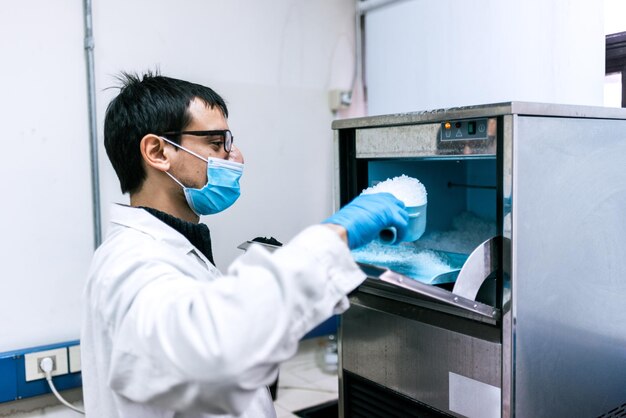In the rigorous landscape of product manufacturing and quality assurance, the role of a Temperature Humidity Test Chamber cannot be overstated. This sophisticated equipment allows businesses to simulate diverse climatic conditions, testing products for endurance and reliability under varying temperature and humidity scenarios. Such testing is pivotal for complying with stringent industry standards, which dictate the resilience and safety of products in real-world conditions. By identifying potential failures and material weaknesses before products reach the market, these chambers serve as an essential tool in safeguarding brand reputation and consumer trust. But how exactly does this technology align with compliance needs across different industries?
A Temperature Humidity Test Chamber is a specialized device designed to simulate various climatic conditions to assess the durability and performance of materials and products under controlled temperature and humidity scenarios. These chambers are integral for environmental simulation, providing a rigorous setting in which to evaluate the resilience and longevity of products against climatic extremes that they may face in actual usage.
Through precise climate testing, manufacturers can ensure product reliability, reducing the risk of failures due to environmental stresses.
The chambers effectively mimic a wide array of humidity and temperature conditions, crucial for understanding material performance across different environments. By adhering to industry standards, the use of these chambers helps businesses in not only meeting compliance requirements but also in maintaining consistent quality and functionality of their products.
This testing apparatus is versatile in its applications across various sectors including electronics, automotive, and aerospace, where reliability under environmental stress is paramount.
Employing a temperature humidity test chamber in the product development phase enables companies to identify potential material degradation and functional issues before mass production, thereby safeguarding brand reputation and consumer trust through enhanced quality assurance.

The primary purpose of a temperature and humidity chamber is to simulate environmental conditions, enabling the testing of products' resilience and performance under varying climatic extremes. These chambers are crucial for ensuring that products meet rigorous industry standards and maintain their functionality and integrity in diverse settings.
Here's how these chambers serve businesses:
Employing temperature and humidity chambers in product testing enables manufacturers to predict product behavior and lifespan under adverse conditions, thereby enhancing product reliability and consumer trust. This strategic approach not only assures compliance but also promotes superior product quality and longevity.
Constructed to exacting standards, temperature humidity test chambers feature a well-insulated stainless steel inner chamber, integral to maintaining consistent testing conditions. The choice of stainless steel as the primary chamber material not only ensures durability and resistance to corrosion but also facilitates precise control over the environment inside the chamber.
Insulation techniques are critical in minimizing thermal loss and enhancing the efficiency of the chamber. Advanced insulation materials, often including high-density foam or fiberglass, are employed to maintain uniform temperature and humidity levels, regardless of external conditions. This robust insulation helps in stabilizing the internal environment, which is crucial for reliable test results.
The heating mechanisms in these chambers are designed to provide rapid and uniform temperature increments as required. Similarly, the cooling systems, typically based on refrigeration, are essential for bringing down the temperature quickly and efficiently to meet test protocols. These systems work in tandem to prevent thermal shock while transitioning between different test conditions.
Humidity control is achieved through a combination of water spray mechanisms and dehumidification systems. These components allow for precise adjustments of moisture levels, critical for testing scenarios that simulate varying climatic conditions. Effective humidity management ensures that the chamber can accurately replicate the required humidity settings for standardized testing.

Temperature humidity testing is instrumental in identifying a variety of potential weaknesses in products, including material degradation, seal failures, and electrical malfunctions. This rigorous testing simulates diverse environmental conditions to ensure products meet industry standards and maintain robust product performance under stress.
The following are critical areas where temperature humidity testing can reveal significant vulnerabilities:
Material Degradation
Seal Failures
Electrical Malfunctions
Structural Weaknesses
Temperature humidity testing is a vital process for identifying and addressing potential weaknesses before products reach the market. It helps manufacturers ensure that their products can withstand environmental challenges, maintain performance, and meet regulatory standards. By addressing these vulnerabilities early, businesses can reduce the risk of product failure, improve reliability, and enhance customer satisfaction.

For industries requiring precise environmental testing, the Temperature Humidity Test Chamber for Industry Standards Compliance proves indispensable.
These chambers are critical for ensuring product reliability, safety, and compliance across various industries.
Understanding the variety of temperature and humidity chambers available is key to selecting the right equipment for specific industry needs. Each type is designed to meet different testing requirements, such as performance testing, environmental simulation, product validation, quality assurance, and compliance testing.
Here are four main types:
Selecting the appropriate chamber type ensures precise control over test conditions, leading to reliable product development and compliance with industry standards.

Equipped with advanced features, temperature and humidity chambers offer precise control of environmental conditions, crucial for compliance with industry standards. These chambers are vital for performance testing, where accurate environmental simulation is necessary to ensure product durability and functionality under varying climatic conditions. The capability to rapidly adjust temperature and humidity enables effective stress tests, including thermal shock and accelerated aging, aiding in robust product validation.
The chambers come with advanced monitoring and control systems featuring user-friendly digital interfaces. These systems allow for real-time adjustments and remote monitoring, facilitating compliance assurance through meticulous control over testing parameters. This feature is essential for industries where adherence to specific environmental conditions is critical.
Moreover, temperature and humidity chambers are available in various sizes, from compact units suitable for small components to large walk-in chambers designed for bulk or large-scale items. This versatility ensures that businesses can conduct quality control tests irrespective of product size, enhancing the reliability of the data.
The accuracy and repeatability of the results generated by these chambers are paramount, providing businesses with the confidence that their products meet stringent quality standards and regulations.

Technical specifications of temperature and humidity chambers define their operational limits, including temperature ranges, humidity levels, and control accuracy. These chambers are essential for performance evaluation, ensuring products meet rigorous quality assurance and compliance testing standards. Precise control mechanisms are crucial for achieving the desired environmental conditions required for reliable environmental simulation.
Here are key technical specifications:
These specifications are integral for businesses to conduct thorough compliance testing and guarantee that their products can withstand diverse environmental conditions. Enhanced control features allow companies to simulate precise environmental scenarios, thereby aiding in robust product development and certification processes.
Temperature and humidity chambers play a vital role in product testing and quality assurance across industries. Here are the core benefits:
Temperature and humidity chambers are essential for enhancing product performance, ensuring compliance, and reducing the risk of failures in various applications. They empower businesses to deliver reliable and durable products in competitive markets.
Selecting the right temperature humidity test chamber is a critical step in maintaining the integrity and compliance of manufactured products. For businesses focused on precision and control, understanding the key aspects of chamber selection is essential. Here are four crucial factors to consider:
Testing Requirements:
Performance Evaluation:
Manufacturer Support:
Cost Comparison:
Temperature humidity test chambers typically last 8-15 years, depending on calibration requirements, environmental conditions, and adherence to temperature control and humidity levels. Regular maintenance can significantly extend the chamber lifespan.
Maintaining temperature humidity test chambers requires regular cleaning, calibration checks, and fan inspections. Sensor calibration and condensation prevention are crucial for optimal performance, ensuring the chamber doesn't become a high-tech sauna gone rogue.
Yes, advanced temperature humidity test chambers can simulate altitude conditions, enhancing their testing capabilities. This feature ensures accuracy in replicating diverse environmental conditions, crucial for validation and compliance with stringent industry regulations.
Temperature humidity test chambers include crucial safety features such as over-temperature protection and fail-safe shutoffs, enhancing efficiency, durability, and chamber lifespan. Regular maintenance procedures ensure operational integrity, crucial for businesses prioritizing control and reliability.
In conclusion, the Temperature Humidity Test Chamber stands as a sentinel in the realm of product reliability and industry compliance, offering a bastion against the unpredictability of material behavior under extreme conditions.
Through its rigorous simulations, it not only fortifies product integrity but also enhances consumer trust and safety.
Businesses that harness the power of this technology find themselves well-equipped to navigate the stringent demands of industry standards, ensuring a lasting legacy of quality and excellence.
Founded in 1988, ASLI (China) Test Equipment Co., Ltd. produces high-quality inspection instruments and testing equipment, including temperature and humidity chambers, aging testers, and vibration testers. Certified to international standards, ASLI serves research, quality inspection, and educational sectors worldwide, renowned for precision, reliability, and exceptional customer service.
Contact us for a free quote of your ideal Temperature Humidity Test Chambers!

